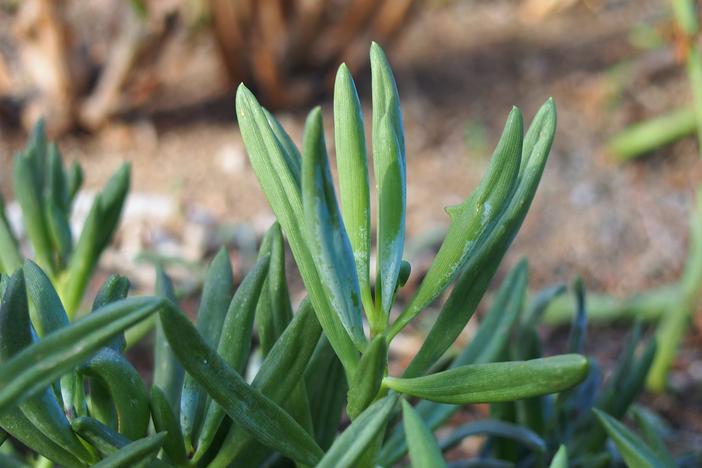Blue Chalksticks
(Curio repens)
Blue Chalksticks (Curio repens)
/
/

Agnieszka Kwiecień, Nova
CC BY-SA 4.0
Image By:
Agnieszka Kwiecień, Nova
Recorded By:
Copyright:
CC BY-SA 4.0
Copyright Notice:
Photo by: Agnieszka Kwiecień, Nova | License Type: CC BY-SA 4.0 | License URL: https://creativecommons.org/licenses/by-sa/4.0 | Uploader: Nova | Publisher: Wikipedia Commons




























Estimated Native Range
Summary
Curio repens, commonly known as Blue Chalksticks, is an evergreen succulent native to the rocky outcrops and sand dunes along the coast of the Western Cape in South Africa. It typically forms a dense mat reaching about 20 cm in height, with distinctive silvery-blue, finger-like fleshy leaves that contribute to its ornamental value. The small, round, pompom-like flowers emerge in clusters, primarily between spring and autumn, and are not particularly showy from a distance, appearing off-white with subtle yellow and pink tinges on the stamen when viewed up close.
Blue Chalksticks is valued for its drought tolerance and is commonly used as a ground cover, border plant, or in rock gardens due to its low-growing habit and attractive foliage. It thrives in sandy, well-drained soils and can tolerate dry to slightly moist conditions. While it prefers full sun to part shade, it is adaptable and can be grown in various light conditions. This plant is easily propagated by cuttings, making it a convenient choice for gardeners. It is important to avoid overwatering to prevent root rot. In regions where it is not native, care should be taken as it can become invasive in similar climates.CC BY-SA 4.0
Blue Chalksticks is valued for its drought tolerance and is commonly used as a ground cover, border plant, or in rock gardens due to its low-growing habit and attractive foliage. It thrives in sandy, well-drained soils and can tolerate dry to slightly moist conditions. While it prefers full sun to part shade, it is adaptable and can be grown in various light conditions. This plant is easily propagated by cuttings, making it a convenient choice for gardeners. It is important to avoid overwatering to prevent root rot. In regions where it is not native, care should be taken as it can become invasive in similar climates.CC BY-SA 4.0
Plant Description
- Plant Type: Succulent
- Height: 0.5-0.7 feet
- Width: 1-2 feet
- Growth Rate: Moderate
- Flower Color: N/A
- Flowering Season: Summer
- Leaf Retention: Evergreen
Growth Requirements
- Sun: Full Sun, Part Shade
- Water: Low, Very Low
- Drainage: Fast
Common Uses
Border Plant, Drought Tolerant, Fire Resistant, Groundcover, Low Maintenance, Potted Plant, Salt Tolerant, Street Planting
Natural Habitat
Rocky outcrops and sand dunes along the coast of the Western Cape in South Africa
Other Names
Common Names:
Scientific Names: , Senecio serpens, Curio repens, Kleinia repens, Cacalia repens, Notonia glauca, Cacalia glauca, Senecio succulentus,
GBIF Accepted Name: Curio repens (L.) P.V.Heath